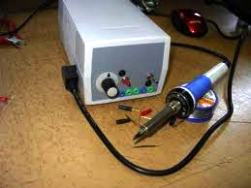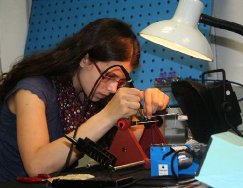Categories: Novice electricians, Electrical Reviews
Number of views: 197336
Comments on the article: 3
How to choose a soldering iron and organize a soldering workstation
Previous article on this topic: What is soldering? Soldering Safety
 Soldering iron - The main tool for soldering. The convenience with which you solve the tasks depends on its correct choice. Soldering irons vary in design and power. Rod sticks are available with ceramic and spiral heaters. Soldering irons with spiral heaters are practical and durable, but they warm up for a relatively long time. Ceramic soldering irons heat up much faster, but at the same time require careful use and a very careful attitude, since any blow can damage such a soldering iron.
Soldering iron - The main tool for soldering. The convenience with which you solve the tasks depends on its correct choice. Soldering irons vary in design and power. Rod sticks are available with ceramic and spiral heaters. Soldering irons with spiral heaters are practical and durable, but they warm up for a relatively long time. Ceramic soldering irons heat up much faster, but at the same time require careful use and a very careful attitude, since any blow can damage such a soldering iron.
According to their power, soldering irons can be different. Traditional soldering irons have the following capacities:
- 3 - 10 W soldering irons are designed for desoldering very small microcircuits,
- soldering irons of 20 - 40 W are considered household and amateur,
- soldering irons 60 - 100 W are used, for example, by car service employees for desoldering thick wires,
- 100 - 250 W soldering irons are used for sealing pots, radiators, and other bulky metal.
The more powerful the soldering iron, the more bulky it is. For different works, it is desirable to have two soldering irons of a different type. Most printed circuit boards and simple amateur amateur homemade products can be soldered using a 25 - 40 W soldering iron with a straight or curved tip. For larger work, soldering irons of 100 watts or more should be used.
If you are already know how to solder, then it is advisable to purchase not just a soldering iron, but a soldering station, which has such advantages:
- adjustable heating range (the probability of burning components is reduced to zero),
- maintaining a constant temperature of the tip (the tip does not burn out, which means that the cost of consumables is reduced),
- An important feature of all soldering stations is the presence of a stand for a soldering iron (a necessary thing) and a bath for a cleaning sponge - do not want to buy a station, you will look for these things separately.
Soldering stations several times increase the quality and speed of soldering. But in order to successfully use all the advantages of soldering stations, you need to be able to solder well, and this requires many hours of practice and experience.
For soldering training Soldering Station not needed, but enough of any ordinary soldering iron 25 - 40 watts. It is better to buy immediately with a temperature controller (with a temperature sensor) or at least with a power controller (without a temperature sensor). Do not immediately buy expensive equipment such as a soldering station or a ceramic soldering iron. Learn from simple things.
Soldering Iron Supply Voltage
In Russia, the standard is voltage 220 V ± 10%, 50 Hz. From the point of view of safety, it is recommended to have soldering irons with a voltage of no higher than 36 V. For soldering in a car or in places where it is difficult to find a socket, you can find a soldering iron with a power supply of 12/18/24 V or gas soldering irons.
Sting shape
 This is an important parameter when choosing a soldering iron. Now a wide assortment of tips is offered for soldering irons - a shovel, cone, needle, etc. What to choose is your business: it is convenient for everyone to solder with what he is used to. Convenient, for example, a set of blades of different sizes. A correctly selected sting facilitates the work, so you should have several thin conical and flat stings and one flat wide for soldering microcircuits.
This is an important parameter when choosing a soldering iron. Now a wide assortment of tips is offered for soldering irons - a shovel, cone, needle, etc. What to choose is your business: it is convenient for everyone to solder with what he is used to. Convenient, for example, a set of blades of different sizes. A correctly selected sting facilitates the work, so you should have several thin conical and flat stings and one flat wide for soldering microcircuits.
Sting resistance
Another important feature of the soldering iron is the resistance of the tip. Soldering tips often have to be replaced. There are heat-resistant stings that are not afraid of prolonged exposure to high temperatures.
In addition to all the criteria listed above, there are several more things that you need to pay attention to when choosing a soldering iron.First of all, it is the thermal insulation of the handle, i.e. how well the soldering iron handle is isolated from the heating part and the ability to control the length of the tip. Most often, the soldering iron tip can be adjusted using a screw on the case. Unfortunately, the technology for stabilization of the tip is provided by no means for all soldering irons, and you need to pay attention to this, because with regular file cleaning, the sting decreases and it needs to be dealt with somehow.
Soldering Iron Stand
 The included soldering iron is heated to 300 ° C, so we put it on the stand (or insert it into the stand, depending on its design), to our right, on the edge of the table. We comply with safety rules, control its network wires and warn others.
The included soldering iron is heated to 300 ° C, so we put it on the stand (or insert it into the stand, depending on its design), to our right, on the edge of the table. We comply with safety rules, control its network wires and warn others.
Soldering tool
Together with a soldering iron it’s nice to get various accessories and tools. If you once worked with a good tool, then you are unlikely to want to work with a bad one. Therefore, it is better to buy a good tool once than a bad one several times.
For soldering, you will need such tools:
- small wire cutters - for wires, part leads and stripping,
- file - for cleaning the tip of the soldering iron,
- tweezers - so as not to burn your fingers,
- a medical scalpel or clerical knife,
- a needle from a syringe with a blunt tip,
- thin awl.
As you gain experience in the repair and manufacture of electronic circuits, this arsenal of yours will gradually expand and be modified.
How to organize a soldering workstation
A good workshop, and especially a set of tools, has been created for years. Moreover, when skill comes, the purchased tools no longer meet our requirements, we have to make our own tools. But for this you need to have not only a workplace, but also the appropriate equipment.
The workshop is needed not only for working with electronic devices and structures, but also for general homework. Modern apartments, as a rule, do not leave us the opportunity to equip our workplace in a separate room, so you can use any free corner. Fastening shelves to a wall, planning a corner and a lower cabinet is a matter of your imagination and skill.
To place the tool, you can use strips with permanent magnets or a home-made set of magnetic door latches. On the surface of the table, equip a special field covered with asbestos - for working with a soldering iron, acids and solvents.
 For particularly small parts for one purpose, fit the plastic cactus boxes glued (fastened) into the stacked cash drawer. Or buy special containers at a specialty store. For medium-sized parts, rectangular sour cream boxes are suitable, which have very comfortable sides that fit well into specially cut grooves. Chips, in addition to standard plastic boxes, are conveniently stored in polystyrene sheets enclosed in a shoe box.
For particularly small parts for one purpose, fit the plastic cactus boxes glued (fastened) into the stacked cash drawer. Or buy special containers at a specialty store. For medium-sized parts, rectangular sour cream boxes are suitable, which have very comfortable sides that fit well into specially cut grooves. Chips, in addition to standard plastic boxes, are conveniently stored in polystyrene sheets enclosed in a shoe box.
The cabinets at the top and bottom can accommodate spare parts, an electric drill (small drilling machine), LATR, various files, a jigsaw, a small hand drill, various containers with varnishes, adhesives, solvents and ferric chloride. Allocate a special place for measuring instruments, separately place a small vise with an anvil, a large vise, etc.
Take care of a container with low sides and a large enough area for garbage - bitten conclusions and removed braid. A plastic disposable plate is very suitable for such garbage (do not touch its tip with a heated soldering iron!).
Power and workplace lighting
It is imperative to provide local lighting for the workplace. Earlier, an article was published on our website with instructions for manufacturing a powerful table lamp. See: do-it-yourself eternal table lamp. This lamp is ideal for small jobs with a heavy load on the eyesight.
Light should fall on the board so that the hand with the soldering iron does not cover it. The power supply in the laboratory must provide: adjustable constant voltage (rectified) and alternating 0 - 250 V (LATR) power for the soldering iron and any desired DC voltage to power any electronic structures.
Continuation of the article:Solders and soldering fluxes
See also at bgv.electricianexp.com
:
